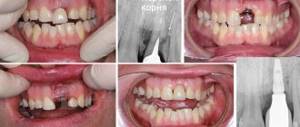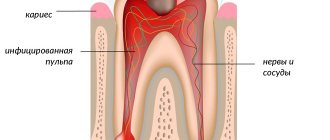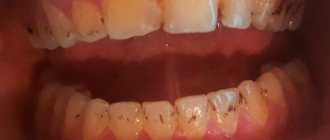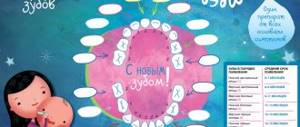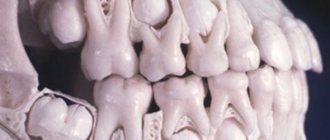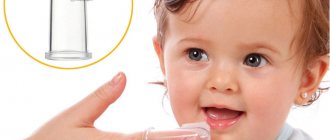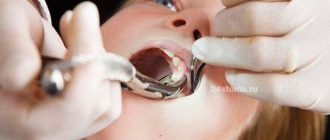From the age of six months, children begin to bother their parents with frequent tears. And the cause of these tears is toothache. After all, it is at this age that babies begin to erupt their baby teeth. And only at the age of six these baby teeth are replaced by permanent ones. Many parents who worry about their babies begin to wonder about various questions regarding the structure of teeth. After all, this is the key to unraveling why and under what circumstances pain occurs. In this article we will tell you whether there are nerves in a child’s baby teeth .
Differences from adult pulpitis
Pulpitis
The structure of baby teeth is different from permanent teeth. They have practically no roots, very thin enamel and large pulp. Because of this, caries flows into pulpitis much more easily and quickly - it needs to overcome a very small barrier to the dental nerve.
At the same time, the baby teeth themselves are smaller in size than the molars, and this complicates treatment - there is a high risk of damaging the pulp chamber, and cleaning the canals is very problematic.
At the same time, childhood pulpitis is characterized by a very rapid transition to a chronic form. That is, severe pain does not last long and then goes away, but the tooth remains painful and can get sick again, provoke inflammation of neighboring teeth, or even cause destruction of the permanent tooth germ.
All these features interfere with diagnosis and treatment, so it is important that this is done by a pediatric dentist who is familiar with the specifics of pulpitis of primary teeth. An adult doctor usually does not have enough experience and skills to treat.
Is there a connection between the nerves of the molar and baby teeth?
According to statistics, every second parent wonders whether there are nerves in baby teeth? And at the same time, most are sure that baby teeth simply do not have nerves. However, such a statement is misleading. In reality, every tooth contains a nerve. It doesn’t matter at all whether we are talking about molars or baby teeth. It is worth noting that the nerve is the most important component of the tooth.
And although nerves are present in both teeth, there is no connection between them. That is why, if a disease such as pulpitis is detected in a baby tooth, there is no need to fear that it will necessarily be diagnosed in a permanent tooth. However, this does not mean at all that you can avoid treatment at all and not visit a dentist. Indeed, in cases where the children’s parents neglected treatment, the inflammatory process was guaranteed to penetrate the bone tissue. This has a negative impact on the process of permanent tooth formation.
When treating baby teeth, doctors must take into account the age of young patients. This need is due to the fact that closer to the age of 6, the roots of non-permanent teeth begin to dissolve. Consequently, at this age, during treatment, the risk that a molar tooth will be injured increases many times over. That is why, in cases where it is necessary to remove a nerve, the canals are processed exclusively at the mouth. In this case, the tooth that has been treated is covered with a solution. This solution helps it survive until the time when the molars are replaced.
Causes of pulpitis in children
Pulpitis in children
The causes of pulpitis in children are basically the same as in adults.
Untreated caries in time. Under the influence of caries, the tooth is gradually destroyed, and bacteria sooner or later penetrate into the pulp, causing its inflammation. Since the enamel and dentin of baby teeth are very thin, caries can sometimes develop into pulpitis in a few months or even weeks, that is, very quickly. In addition, the situation is complicated by the fact that parents often do not pay attention to childhood caries, since “the teeth will soon fall out anyway.”
Injury to a baby tooth. This often happens during play - the child hits his face and the teeth seem to be intact, but in fact the root or pulp is damaged. As a result, due to trauma, pulpitis can develop even in a tooth that outwardly appears completely healthy.
Medical error in the treatment of caries. Since a child's pulp is very close to the surface of the tooth, during normal caries it is easy to accidentally damage the tissue and open the pulp chamber. And even if there is no injury, the pulp can become inflamed simply due to exposure to the filling material, too strong an antiseptic, and even overheating during treatment. Most often, this happens when a child is treated by an inexperienced dentist or an “adult” doctor who is not accustomed to working with baby teeth.
Acute infection. Sometimes bacteria penetrate the pulp not from the outside, but from the inside, through the blood. This happens if a child suddenly gets sick with something, for example, a sore throat. Such “internal” pulpitis is rare, but you need to be aware of its possibility in order to connect a recent illness and toothache in time.
How are permanent teeth different from molars?
The most obvious difference is the number of teeth. A person has 28-30 molars, but only 20 primary teeth. There is a difference in the size of the crowns and even the roots of the teeth. According to dentists, baby teeth are smaller than molars. This is explained by the fact that children have a much smaller jaw than any adult. Consequently, it is not able to accommodate teeth the size of molars.
The thickness of dentin and enamel also differs significantly. In baby teeth they are much thinner. But if the dentin and enamel of primary teeth are inferior in thickness to molars, then in the case of pulp volume, it is the non-permanent teeth that take precedence. An interesting fact is that it is not necessary to visit a dentist to remove a baby tooth. But if we are talking about removing a molar incisor, you cannot do without the help of a qualified dentist. After all, this process takes much longer and is characterized by pronounced pain, increased body temperature, and slight bleeding from the gums.
Symptoms of pulpitis of baby teeth
The following symptoms are characteristic of childhood pulpitis.
Strong pain. Most often it occurs in the evening and at night, or during chewing and pressure. In addition, the child may refuse to eat hot or cold food or complain of pain outside in the cold.
There is one problem with this symptom - due to the rapid transition of pulpitis into chronic pain, the pain can go away in just a couple of days, so sometimes the child simply does not have time to complain, and the parents do not have time to react.
In addition, if pain bothers a very young child, he often cannot clearly explain what is wrong, so you need to focus on external signs - crying, moodiness, refusal to eat.
A noticeable carious cavity on a tooth . This is not a mandatory sign - sometimes the tooth is externally intact, but the pulp in it is inflamed. However, if a child complains of pain or feels unwell, and one or more teeth are damaged, this is a sign of pulpitis.
Loosening of the tooth. Due to injury or destruction of the pulp, the tooth may begin to become loose, although it is too early for it to fall out.
Increase in temperature and deterioration in general health . It is especially common in young children, as they react particularly acutely to inflammation.
Swelling or swelling of the cheek. It doesn't happen very often, but it is a clear sign that something is wrong with your teeth. This can be a symptom of both pulpitis and periodontitis or periostitis - a doctor will make an accurate diagnosis.
All these symptoms are weak and unexpressed, sometimes even the child himself ignores them. Only a doctor can accurately diagnose pulpitis, and various methods are used for this, from a simple examination to an x-ray. Therefore, it is important, even in childhood, to regularly take your child to the dentist in order to recognize the disease in time.
When to see a doctor?
The main danger of pulpitis lies in the ability of inflammation to quickly reach a critical point, beyond which there can be no talk of gentle intervention. The need for relatively long-term treatment of pulpitis can place the child under stress, which can hardly be called a desirable or beneficial condition.
But there is good news: pulpitis is quite easy to suspect, even without being a specialist in dentistry. And if the disease is detected in time, pulp removal is much faster and painless than in advanced cases.
To prevent negative consequences, you should not hesitate to consult a doctor if the following symptoms appear:
- the child complains of a dull, bursting pain in the tooth;
- the pain intensifies briefly after consuming hot food or drinks, and at night;
- the child avoids chewing food with the side on which the sore tooth is located;
- an unpleasant, putrid odor appears from the child’s mouth, which weakens slightly after brushing the teeth;
- Any defects on the diseased tooth are visually determined (crack, chip, dark spot, carious cavity).
At what age does pulpitis occur in children?
Development of pulpitis
Some parents believe that a small child cannot develop caries, not to mention pulpitis. They think that a newly erupted tooth is protected from disease, so they do not examine the child’s mouth or take him to the dentist.
However, children's teeth are actually very susceptible to disease. The risk of developing pulpitis is especially high in cases where the child is often given sweets, but even if you do not overfeed the baby with sugar, his teeth can still get sick.
Even at two years old, pulpitis can affect the front milk teeth. But at 3–4 years of age, caries and pulpitis most often affect the posterior chewing teeth, while the anterior teeth remain virtually unaffected by inflammation.
Does it hurt or not?
The sensitivity of teeth is provided by a nerve that is located in the pulp tissue. For this reason, both the pathology itself and the process of its elimination presuppose the presence of pain.
Dentistry has ample opportunities for painless treatment of pulpitis. Anesthesia is used for this. Modern drugs are safe and do not pose a risk to the child’s health.
Methods of dental anesthesia.
- Local anesthesia. An anesthetic is injected into the soft tissues, eliminating any sensation for a certain period of time. To ensure that the child does not feel the injection, topical anesthesia is additionally used.
- Sedation. The method is also called “medicated sleep.” Pain relief is achieved by placing the child under a mild general anesthesia. To administer the anesthetic, intravenous and inhalation methods are used. The duration of anesthesia is from 10 minutes to 2 hours.
When treating young children under 5 years of age, dentists give preference to medicated sleep. It is difficult for a child to simultaneously cope with fear and maintain a calm position, which can complicate the procedure and cause tissue injury. Sedation allows you to eliminate psychological trauma and any painful sensations, as well as make the dentist’s work easier and speed up the treatment process.
Why do you need to treat pulpitis of baby teeth?
Often parents believe that baby teeth do not need to be treated at all. If they do not bother you, it is better to simply not touch them, and if they do bother you, remove them, since the tooth will soon fall out anyway. But there are several reasons why treating childhood pulpitis is very important:
- Acute inflammation can spread to the germ of a permanent tooth, and it will immediately erupt into the patient.
- Extracting a tooth too early will lead to malocclusion - baby teeth will move into empty space, and permanent teeth will erupt incorrectly because of this.
- Pain in an untreated tooth can periodically return and greatly ruin a child’s life and interfere with chewing food normally.
- Losing a tooth at an early stage of speech formation can cause serious speech therapy problems - the child will not be able to pronounce individual sounds normally.
For all these reasons, even baby teeth need treatment.
Why do children under 14 years of age have an increased risk of caries and pulpitis?
During the period of formation of a permanent dentition, when the child’s permanent teeth begin to erupt, there are 2 factors that increase the likelihood of developing dental diseases and parents need to take them into account.
- The anatomical features of “freshly erupted” permanent teeth contribute to the development of caries and its complications. The incompletely formed, delicate enamel of young permanent teeth, especially in the area of numerous fissures (grooves) on the chewing teeth, is very vulnerable.
- A psychological feature of the “difficult” transitional age, when it is not easy to persuade a child to brush his teeth correctly and thoroughly, and, even more so, to go to the doctor and cure caries in a timely manner, especially if the child is afraid of the dentist.
Treatment of pulpitis in children
There are several ways to cure pulpitis of a baby tooth.
Classic non-vital amputation
This method is now considered outdated, but it is still used in some clinics, especially in free public dentistry. The essence of this method is as follows:
- The doctor drills out the carious tissue, opens the pulp and applies a special paste to it that kills the nerve. Previously, pastes with arsenic were used - they killed the nerve in two days, but were not very beneficial for health. Now they use safer means, but they take a week to kill the nerve.
- When the nerve is killed, a special mixture is pumped into the tooth to mummify the pulp. Sometimes the pulp is partially removed.
- At the last visit, the doctor installs a permanent filling.
In adults, this method is now practically not used, since the tooth turns gray after it, and the pulp can become inflamed. However, when treating baby teeth, the method has the right to be used, since the baby tooth will still quickly fall out, and pulpitis will not have time to reoccur.
The main advantage of this technique is its simplicity and low cost. The treatment can be carried out by almost any dentist, so in rare cases the use of this method is justified. But in order not to expose the child’s body to stress, it is better to use other treatment methods.
Vital pulp extraction
This method exists today thanks to the advent of modern powerful anesthetics. It is most often used to treat pulpitis in adults, and is often used on children.
The essence of the technique is that, under powerful anesthesia, the living pulp is completely removed from all root canals of the tooth. After this, the canals are carefully processed and then filled with a special paste.
In adults, gutta-percha is used for filling, but it does not dissolve over time—in a child’s tooth, this would prevent it from falling out. Therefore, for children, the canals are filled with zinc-eugenol paste, which will gradually dissolve along with the roots.
This method is good, but requires special skill of the doctor, as well as the use of expensive materials and instruments. Therefore, treatment of pulpitis using this method is rarely offered in public clinics, and in paid clinics it can cost several thousand per tooth.
Vital amputation
This is a very rare method, since it is applicable only at the very beginning of the onset of pulpitis. That is, you need to run to the doctor as soon as the child complains of tooth pain - only then will this method be effective.
Its essence lies in the fact that under anesthesia, only the inflamed area of the nerve is removed from the tooth. An antiseptic and anti-inflammatory medicine is applied to the rest of the nerve, and then everything is carefully sealed. This technique allows you to partially preserve the pulp and extend the life of the tooth, but when using it there is a high risk of recurrent pulpitis.
Methods for depulpation of the dental nerve
The method of removing a nerve in a baby tooth is determined by the stage of pulpitis and the degree of tissue damage. Treatment may involve partial or complete depulpation. The decision on the method of performing the procedure is made by the attending physician.
At the Martinka Children's Dental Clinic, dental nerve removal for children is performed using two methods.
- Chemical. The dentist puts a drug into the tooth cavity that “kills” the nerve. The drug does not affect healthy tissue. While the paste is in effect, a temporary filling is placed on the tooth. After 1–5 days, the filling is removed, and the pulp and nerve are removed. The method is only available for complete depulpation.
- Instrumental. The child is given anesthesia to relieve pain. The tooth is opened and the pulp is removed completely or partially using special instruments. At the end of the procedure, a medicinal paste with anti-inflammatory and antiseptic action is placed into the tooth cavity. A temporary filling is installed. After a few days, the drug is removed and a permanent filling is installed instead of a temporary filling.
If the inflammatory process has started, then upon completion of treatment, the dentist may prescribe a course of antibacterial drugs. Taking painkillers is permissible only as prescribed by a doctor.
Prevention of childhood pulpitis
Treating pulpitis in baby teeth is difficult and expensive, so it is best to avoid it. The following preventive measures will help with this:
- Start oral hygiene from the eruption of the very first tooth, and gradually accustom the child to it.
- Brush children's teeth with special toothpastes containing age-appropriate fluoride.
- Avoid giving your child too many sweets, especially sugary drinks. The most dangerous thing is to give a child sweets from a bottle - because of this, the front teeth are often affected by caries, and then pulpitis.
- Make sure your child's diet includes plenty of fresh vegetables and fruits. Solid foods are especially beneficial - they strengthen teeth and help remove plaque.
- Every six months, take your child to the dentist for preventive examinations so that the doctor can notice and treat caries in time.
- At the first signs of even mild dental damage, do not let the process take its course, but take the child to the dentist.
These measures will help you prevent pulpitis and keep your child's baby and permanent teeth healthy.
Features and stages of the procedure
The dentist decides to remove the nerve of a baby tooth.
The procedure begins with a routine examination. It will take the doctor less than half a minute to decide whether to remove the nerve or not. To do this, a temporary onlay is placed on the tooth. Then the removal procedure itself is carried out. Local anesthesia is performed with a solution of ice-caine. The main task of the dentist is to open the tooth enamel using a drill and clean the dental canals so as not to damage the inner row of teeth.
Pulp removal ends with thorough disinfection. After this, the tooth is filled. In difficult situations, a follow-up appointment is scheduled to take an X-ray of the tooth. Sometimes the filling is placed temporarily. A special medicinal composition in the form of a paste is placed under it. And after the time of action of the medicine has expired, the filling is replaced with a permanent one.
Fillings used in dentistry can be of varying quality. There are no uniform standards for doctors. Therefore, parents simply do not know what they are using to glue their children’s mouths shut. But specialized private medical institutions should talk about what materials they work with. Children's fillings, as a rule, have good aseptic characteristics, but their durability is questionable. Dental cement will last about a year and a half.
After the procedure, the tooth is considered dead. It does not react to thermal and acid-base influences. But now it is collapsing at twice the speed. Enamel tubules instead of pulp cannot provide adequate nutrition for the entire tooth.
How is the progression of pulpitis in permanent teeth different in children?
Pulpitis is a serious disease, it must be treated, otherwise you can actually lose a tooth, get gumboil and even blood poisoning.
As in other age groups, pulpitis in adolescents under 14 years of age occurs in 2 main forms:
- Acute, with severe pain at night and in the evening, a painful reaction to temperature and chemical stimuli, an increase in temperature in case of general intoxication and the development of purulent complications.
In the absence of timely adequate treatment, the acute form becomes chronic.
- Chronic. This form of pulpitis can pass painlessly with the appearance of periodic pain reactions to cold, hot, sour, sweet. The acute inflammatory process in the pulp subsides, and the sluggish course of the disease contributes to the development of complications from periodontal tissues. Exacerbations occur periodically.
Attention parents! During adolescence, children may hide the disease and take painkillers uncontrollably.
